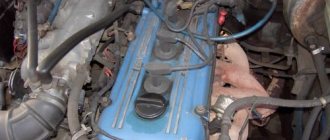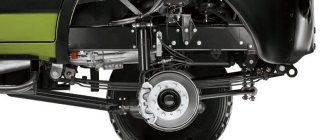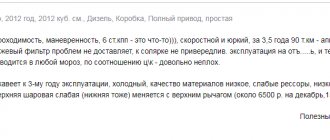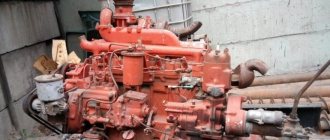A truck is a commercial vehicle. And in commerce (business), two key tasks are: minimizing costs and maximizing profits. How to increase profits is clear - the machine must work without downtime and, if possible, not go idle. How can you minimize costs?
One of the basic cost items in the case of freight transportation is fuel. To reduce costs, you first need to know them. Let's figure out how to calculate the fuel consumption of a truck per 100 km (reference point) and the entire route.
Fuel consumption table for trucks
Truck consumption is not a constant value. Even for one car, it will change with the change of season and as the “work experience” accumulates (in other words, with the age of the car). In addition, this indicator is greatly influenced by both the volume of cargo delivered and the nature of the roads on which the transport travels.
The consumption characteristics indicated in the car's passport are calculated under ideal operating conditions, which means they need to be corrected. For this purpose, official fuel consumption standards have already been developed, presented in the table below.
These are top popular brands. The list is actually longer and is fully presented in the order of the Ministry of Transport of the Russian Federation No. AM-23-r dated March 14, 2008.
Important. The standards approved by the Ministry of Transport are not average or approximate indicators. In fact, they may be different for a specific machine; you need to test this yourself.
The average actual costs of fuel of different types for common brands of trucks on Russian roads were also determined empirically. They look like this.
Again, here you need to understand that the conditions in which the machine is operated, its equipment, constant loading tonnage and other factors can greatly change these indicators. Average consumption is very approximate data; you should not rely on them when assessing the prospects for a delivery order. To calculate fuel consumption per kilometer for your vehicle, you need to take individual measurements.
Chassis
Drive Volvo 670 – 6x4. The air suspension provides increased maneuverability of the vehicle, even on rough terrain. Meritor rear axles are equipped with air springs manufactured by Volvo.
The front axle beam is manufactured by Rockwell, and the structure itself is made by Meritor. The Air Ride pneumatic system guarantees the integrity of the materials in the body and the driver’s comfort while driving. Such advantages allowed the “walker” to receive many positive reviews.
Return to content
How to calculate fuel consumption per 100 km: the simplest methods
How to count? There are 2 approaches - empirical and scientific. In the first case, you need to carry out a test measurement:
- fill the tank “to capacity”;
- reset the daily fuel consumption counter on the panel;
- drive from 100–150 km;
- refill the car tank to 100%;
- look at the receipt to see how many liters are included and calculate fuel consumption based on actual consumption.
Let us look at an example of such a test for clarity. So, let it be a Volvo 850 with a fuel tank capacity of 73 liters. After the first refueling, the car traveled 180 km, according to the meter. When refilling, its tank contained 44.1 liters of diesel. That is, over 180 km of travel the car consumed 44.1 liters of fuel. For 1 km it will be 0.245 liters, for 100 km, respectively, - 0.245 * 100 = 24.5 liters.
It is advisable to make at least 3 such measurements - when driving without a load, being fully loaded, and when driving around the city. Then it will be possible to get a complete picture of how many liters the machine needs to deliver goods, and how much it will spend returning empty. In addition, the nature of the routes must be taken into account.
Important. You need to move during the test without changing your usual driving style. The closer the conditions are to constant, the more accurate the figure will be.
If a car spends 80% of its time on the highway and only 20% of the way moves around the city (and the test is carried out under such conditions), then on the next route through mountainous terrain, for example, the consumption will not coincide with the calculated one. It will be higher because on some routes, where traffic is mainly in low gears, consumption increases significantly.
To calculate fuel consumption along a route (taking into account its characteristics), you need to use a more complex formula. The same applies to flights in which part of the journey is spent moving empty, and part of the journey is loaded in different volumes.
Scientific approach
The scientific method of calculation uses the following formula.
- Qн – required flow rate;
- Hsan – current consumption standards for an empty and loaded vehicle;
- S – mileage according to the waybill (de facto);
- Hw – costs for the part of transportation in which cargo is involved in liters per 100 ton-kilometers;
- W – actually, the volume of transport work (ton-kilometers), which is calculated as the product of the mass of the cargo and the distance of its transportation;
- D – correction factor (for an older car, driving around the city or on a highway), can be either higher than one (the resulting consumption is adjusted upward) or lower (for example, when the car spends 99% of its time on a highway with improved road surface).
To calculate fuel consumption per 100 km using this formula, you need to know the distance traveled, the volume of cargo, the age of the car, its total mileage and the conditions along the route. Let's look at an example.
Fuel consumption calculation
The GAZ-3307 manufactured goods van with a carrying capacity of 4.5 tons delivers drinks in the summer throughout the city and intercity highways (fully loaded). Distance of 1 flight – 120 km. The total mileage according to the waybill is 315 km (200 km in a city of 400 thousand people and 115 km on the highway). The car is old – 2011. (10 years), total mileage shows 220 thousand km.
The basic fuel consumption rate for such a car is 24.5 liters per 100 km. The standard cost for the “loaded” part of the route is 2 liters per 100 km (that is, the amount of work will double). Of the increasing coefficients, you need to use +5% for work in the city, +10% for wear and tear (the car is older than 8 years and has traveled more than 150 thousand km), and -10% for driving on a country road. For convenience, we will divide the calculation into 3 stages.
We apply a simple formula to calculate fuel consumption per 100 km, and we obtain consumption in specific conditions of 96.35/315*100 = 30.59 liters per 100 km.
This approach is quite complicated. In addition, before making calculations, you will have to check the current standards, which change periodically. This is a long time, and time in the transport services industry is quite expensive.
To save it, it’s easier to use a software solution. Now on the Internet you can find a lot of “smart” calculators that already take into account all the corrections and features of the route. They just need to enter data on the car (total mileage, age, make and model, availability of a trailer), set operating conditions and distances to get a ready-made calculation in 5 seconds.
Economic importance of fuel calculations
Fuel cost calculations are becoming a critical component of operating costs. When determining the profitability of transportation, fuel costs reach 40–60% of the payment for the operation of the vehicle. The average consumption rate does not take into account the characteristics of the truck (engine wear), route topography, or time of year. Therefore, the standard consumption diverges from the actual consumption of diesel fuel by significant amounts. By controlling fuel costs, managers of transport companies calculate consumption according to standards, enter into contracts with gas stations, and issue fuel cards to drivers. On long routes in Ukraine and abroad, drivers cannot refuel by bank transfer or plastic card everywhere, so the consumption of funds allocated for fuel is difficult to control. For managers and accountants of motor transport companies, the relevant question is how to determine the rate of fuel consumption so that the truck driver meets the amount of cash allocated to him for refueling. For international road transport, fuel prices in different countries vary significantly. On an international route, the driver of a long-haul truck can travel through several countries during the trip. At the same time, he will have to, on average, refuel with diesel fuel at the following prices (per 100 liters):
- Ukraine - 85 euros;
- Belarus – 70 euros;
- Russia – 53 euros;
- Poland – 114 euros;
- Czech Republic – 116 euros;
- Germany – 122 euros.
How to calculate fuel consumption for a route, knowing the distance
To calculate the total fuel consumption for the entire route, taking into account the distance, you only need to know the starting base. For it you can take the average consumption, standard, actual consumption, determined empirically or according to the formula presented above. If you take the norm as a basis, it needs to be adjusted depending on the conditions of the route (highway, city, mountains, etc.).
Referring to the examples given earlier, the cost of a 282 km journey, for example, would be calculated as follows.
GAS
| GAZ-2310 “Sobol” (ZMZ-40522-4L-2,464-145-5M) | 14,7 | B |
| GAZ-2704 “Farmer” g/p (GAZ-560-4L-2,134-95-5M) | 11,9 | d |
| GAZ-2943 “Farmer” (ZMZ-402-4L-2,445-100-4M) | 16,7 | B |
| GAZ-3302 (ZMZ-405220-4L-2,464-145-5M) | 15,3 | B |
| GAZ-3302 "Gazelle" (ZMZ-4063.10-4L-2.3-110-5M) | 15,5 | B |
| GAZ-3302, -33021 “Gazelle” (ZMZ-4025.10-4L-2,445-90-5M) | 16,5 | B |
| GAZ-3302, -330210 “Gazelle” (ZMZ-4026.10-4L-2,448- 100-4M) | 16,5 | B |
| GAZ-33021 (ZMZ-4025.10-4L-2,445-90-4M) | 16,9 | B |
| GAZ-33021 (UMZ-42150-4L-2.89-89-5M) | 16,6 | B |
| GAZ-330210 "Gazelle" (ZMZ-4026.10-4L-2,448-100-5M) | 16,0 | B |
| GAZ-33023-16 (6 seats) (ZMZ-4026.10-4L-2,445-100-5M) | 15,7 | B |
| GAZ-33027 "Gazelle" (ZMZ-4026.10-4L-2,445-100-5M) | 17,0 | B |
| GAZ-3307 | 24,5 | B |
| GAZ-33073 (ZMZ-511.10-8V-4.25-125-4M) | 24,9 | B |
| GAZ-3309 (GAZ-5441.10-4L-4,15-116-5M) | 17,0 | D |
| GAZ-33104 "Valdai" (D-245.7E2-4L-4.75-117-5M) | 17,3 | D |
| GAZ-52, GAZ-52A | 22,0 | B |
| GAZ-52-01 | 22,0 | B |
| GAZ-52-03 | 22,1 | B |
| GAZ-52-04 | 22,2 | B |
| GAZ-52-05 | 22,3 | B |
| GAZ-52-07, -52-08, -52-09 GAZ-52-27, -52-28 | 30,0 21 | CIS LNG |
| GAZ-53, -53A, -53-12, -53-12-016, -53-12A, -53-50, -53-70 | 25,0 | B |
| GAZ-53-07, -53-19 | 37,0 | CIS |
| GAZ-53-27 | 25,5 (25) | LNG |
| GAZ-63, -63A | 26,0 | B |
| GAZ-66, -66A, -66AE, -66E, -66-01, -66-02, -66-04, -66-05, -66-11 | 28,0 | B |
| Trucks produced before 2008 | ||
| Model | Fuel consumption rate, l/100 km | Type of fuel |
| ZIL | ||
| ZIL-130, -130A1, -130G, -130GU, -130S, -130-76, -130G-76, -130GU-76, -130S-76, -130-80, -130G-80, -130GU-80 | 31,0 | B |
| ZIL-131, -131A | 41,0 | B |
| ZIL-133G, -133G1, -133G2, -133GU | 38,0 | B |
| ZIL-133GYA | 25,0 | D |
| ZIL-138 | 42,0 | CIS |
| ZIL-138A, -138AG | 32 (gasoline 31) | LNG |
| ZIL-150 | 31,0 | B |
| ZIL-151, -151A | 39,0 | B |
| ZIL-157, -157G, -157K, -157KG, -157KD, -157KE, -157KYu, -157E, -157Yu | 39,0 | B |
| ZIL-431410, -431411, -431412, -431416, -431417, -431450, -431510, -431516, -431917 | 31,0 | B |
| ZIL-431610 | 32 (31) | LNG |
| ZIL-431810 | 42,0 | CIS |
| ZIL-4331 | 25,0 | D |
| ZIL-431410 (D-243-4L-4.75-78-5M) | 19,5 | D |
| ZIL-433110 (ZIL-508.10-8V-6.0-150-5M) | 33,0 | B |
| ZIL-43317 (KAMAZ-740-8V-10.85-210-9M) | 27,0 | D |
| ZIL-433360 (ZIL-508.100040-8V-6.0-150-5M) | 31,5 | B |
| ZIL-433362 (ZIL-375-8V-7.0-175-5M) | 36,2 | B |
| ZIL-4334 (8V-8.74-159-5M) | 25,3 | D |
| ZIL-5301 (D-245 MMZ-4L-4.75-105-5M) | 14,8 | D |
| ZIL-5301 PO (Caterpillar-3054-4L-3.9-136-5M) | 15,0 | D |
| ZIL-534330 (YaMZ-236A-6V-11.15-195-5M) | 20,5 | D |
| Trucks produced before 2008 | ||
| Model | Fuel consumption rate, l/100 km | Type of fuel |
Fuel consumption in winter
To what has been said, it remains to be added that all calculations, tests and measurements must be carried out separately for the warm and cold seasons. Because the indicators in winter and summer are different. This is due both to the manner of driving on a dry summer road or slippery winter road, and to the peculiarities of operating vehicles in cold weather. In winter, tire pressure changes, the engine requires more energy (read: fuel) to warm up, and the engine also cools down faster. As a result, consumption increases.
To decide how to calculate winter fuel consumption, you need to know the specific operating conditions during a cold five-day period. If the car drives only in the central and southern districts, for example, summer measurements can be increased by 10–15%. If routes will affect regions with lower temperatures, the average flow rate must be adjusted upward by 20–25%. Or collect actual measurements separately.
Which tractor is the most economical?
Tractor
The Scania R450 has received the Green Truck 2022 award as
the most fuel-efficient
and environmentally friendly commercial vehicle in its class. This is the third consecutive victory for Scania trucks in the ranking organized by the German industry publications VerkehrsRundschau and Trucker.
Interesting materials:
Which is better, two or four cores? Which is better exfat or ntfs? Which is better fat32 or exFAT? What is better fat32 or ntfs for a flash drive? Which is better fat32 or NTFS for an external drive? Which is better fat32 or ntfs? Which is better fifa or pes? Which is better Firefox or Opera? Which is better, flemoxin or azithromycin? What is better Flemoxin or Flemoklav?
What affects fuel consumption
Fuel consumption is not only a transportation cost item, but also quite a diagnostic characteristic. Depending on the condition of the car and the driver’s manner, it can either increase or decrease. It is most influenced by:
- load (car air conditioning, electric drives of the cargo compartment, other demanding equipment significantly increases fuel consumption);
- driving style (frequent slipping, sharp gear changes, driving in traffic jams - the easiest ways to increase consumption);
- aerodynamics (add-ons on the cabin or cargo compartment, open windows - all this disrupts aerodynamics and increases the “appetite” of the car);
- good condition of the engine and its servicing systems (fuel supply and gas distribution, cooling).
Important. Among the critically important points, an increase in fuel consumption may indicate a malfunction (the spark plugs are clogged, the spark “leaks” from the ignition coil), low tire pressure, or the vehicle is overloaded.
Having decided how to calculate fuel consumption by kilometers and liters, let’s figure out how to reduce it. Solutions proven by time and millions of drivers:
- regularly undergo car diagnostics and perform engine maintenance;
- use good oil - consumption depends very much on it;
- make it a habit to coast wherever possible (without gas);
- avoid frequent gear changes and driving in low gears;
- immediately eliminate electronic errors - a system failure creates an additional load, which increases the vehicle’s energy consumption;
- drive with the windows closed, minimize the operation of the air conditioner if possible (or at least install an economical low-power model);
- use high-quality tail lifts and other equipment that provides minimal load;
- refuel at proven gas stations (only by switching to good fuel after cleaning the filters can you reduce consumption by 10–15%).
Reasons for overspending and ways to reduce it
The practice of automobile enterprises shows that even with precise control, there is often a strong overrun. The reasons may lie in the driving style and habits of drivers, as well as in the technical condition of the cars. What exactly can they be, in what ways can the current situation be corrected?
The occurrence of excessive fuel consumption is directly influenced by such factors as aggressive and unsafe driving style, which may involve sudden acceleration or braking. Such driving can increase fuel consumption significantly. Today, to monitor drivers, special monitoring software systems are being created using satellite systems to track areas and locations of speed limit violations and gambling. The implementation of such systems makes it possible to monitor violations in transport management of all rolling stock at once online and with the output of reports, both general and for each violation separately.
In addition to dynamic loads and vehicle overloads while driving, excess consumption may occur in cases of technical malfunction of vehicle components or poorly performed maintenance.
Technical issues affecting overspending and ways to eliminate them are clearly visible in the table.
Table of reasons for high consumption and solutions
| Malfunction | Photo | Remedy |
| Power unit wear: – the coolant temperature is lower than required; – wear of the crank mechanism – problems with the cylinder-piston group; – poorly adjusted valve clearances; – wear of the gas distribution mechanism. | – the use of a special additive for MAX ICE, which is capable of restoring the original engine parameters; – maintenance and repair. | |
| Manual transmission wear | - diagnostics; – use of tribotechnical composition “MAX manual transmission”; - repair; - replacement. | |
| Tire wear | – correctly adjust the wheel alignment; - replace the tires. | |
| Fuel system malfunction | – use of the tribotechnical composition “MAX Fuel Injection Pump” for the restoration of high-pressure fuel pumps; – cleaning the injectors; – use of the “SDA MAX” additive, including for cleaning injectors; – if necessary, replace injectors. | |
| Clogged air filter | – filter replacement. |
Additive for engines of trucks and special equipment "MAX DVS"
The additive is designed to protect against wear, extend service life and restore the characteristics of diesel engines with a displacement of more than 5 liters (5000 cm3) during normal operation.
more reviews
"Suprotek MAX manual transmission." Truck Box Additive
The tribotechnical composition is designed to protect against wear, extend the service life and restore the characteristics of mechanical gearboxes, transfer cases and gearboxes of trucks and special equipment during normal operation.
more reviews
Suprotek MAX injection pump additive for trucks
For injection pumps of diesel internal combustion engines of trucks and special equipment: in-line, distribution, main fuel pumps, COMMON RAIL systems, PUMP-NOZZLE systems.
more reviews
In addition, the reasons for excessive fuel consumption in diesel cars can be a clogged fuel filter, inappropriate engine oil, reduced compression, failure or incorrect operation of sensors, or problems in the operation of the ECU.
Preventative agent "SDA MAX"
It is better to prevent problems than to solve them. This thesis is fully justified by the SDA MAX additive for diesel fuel systems with tank volumes up to 500 liters. It is absolutely safe for fuel filters and removes contaminants gradually. And if you use it constantly - every time you refuel your car, you can achieve ideal cleanliness of the fuel system, prevent the formation of deposits, significantly reduce wear in friction units, prevent the occurrence of oxidation processes and, accordingly, corrosion, and facilitate ignition of the fuel mixture. It restores the original engine parameters and significantly saves fuel consumption.











